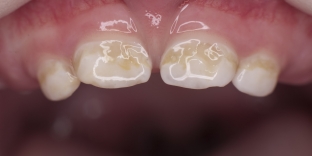Dental health problems can begin as early as childhood. For example, children may develop dental caries that are slightly different in location from normal caries. Caries that occurs in children 1-3 years old is called bottle caries. Also, such caries is called "nursery", "kefir", "feeding caries". These names reflect the age at which caries appears. The longer the bottle feeding period, the higher the risk of developing bottle caries. Why does bottle caries develop in a child?
Causes of bottle caries in a child
Bottle caries develops when the bacterial flora accumulates. Bacteria contribute to the fermentation of carbohydrates, after which organic acids are formed. Thus, acidic – alkaline balance shifts to the acid side. This provokes damage to the enamel and makes the penetration of bacteria more likely into the dentine tubules. In addition to the reasons described above, a special role belongs to a violation of the diet, a change in the composition of saliva and a decrease in the protective properties of the body.
As you know, bottle caries is more likely to develop in children who receive artificial or natural nutrition "on demand"; longer than 12 months. Night feeding has a negative impact on dental health, as food remains on the teeth after feeding.
Mechanism of development and classification of bottle caries
At night, the amount of saliva secreted decreases, so food particles remain on the teeth until morning, acids are not neutralized, and the mineral composition of the enamel is not replenished.
Thus, insufficient oral hygiene, improper feeding regimen and hyposecretion of saliva at night are triggers in the development of bottle caries. What is caries in a child, read on estet-portal.com. Bottle caries, depending on the depth of the lesion, are divided into 4 stages.
Classification of bottle caries:
- The initial stage develops at 10-20 months of age. It is characterized by the appearance of white spots on the vestibular surface of the upper incisors. These are the centers of enamel demineralization. A white line is visualized in the region of the neck of the tooth. There are no subjective sensations. Carrying out treatment – preventive measures at this stage can prevent the further development of bottle caries.
- The stage of superficial caries corresponds to 16 – 24 months and is manifested by the formation of a defect in the tooth enamel and exposure of the dentin.
- The stage of medium caries corresponds to 20-36 months and is characterized by the destruction of enamel. Dentin is partially destroyed.
- The stage of deep caries develops at 30-48 months and is detected by damage to the enamel and most of the dentin.

How does the development of bottle caries affect the appearance and life of a child?
The mechanism of sucking determines the development of bottle caries on the upper incisors and canines.
When grasping the nipple or breast, the baby's tongue covers the teeth of the lower jaw and the upper front teeth come into direct contact with the food. It is in these areas that food residues accumulate more.
Bottle caries develops with circular spread – around the crown of the tooth. Yellow – brown or black spots indicate the progression of bottle caries. There is also an increased sensitivity to hot or cold food.
Violation of the aesthetic appearance of the teeth spoils the sweet smile of a child, and the bacterial flora is a focus that can cause the development of the disease. Therefore, from the first years of life, it is important to take care of the condition of the child's teeth in order to prevent bottle caries.







Add a comment